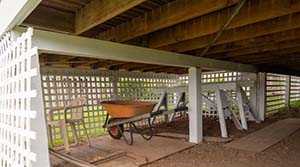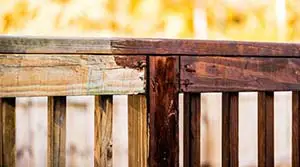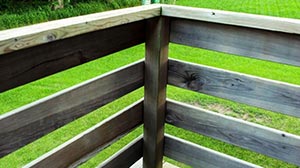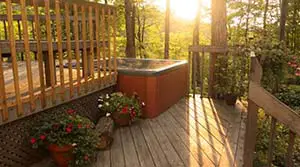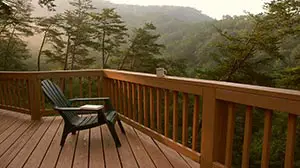
Sealing and staining will result in a more durable deck surface. Stained decks also look more aesthetically beautiful, which may make you excited to stain them without giving them much time to dry immediately. So how long do you need to dry a deck before staining?
Forty-eight hours is the perfect drying time for newly washed decks in most cases. However, this assumes optimum drying conditions, including a sun-facing deck.
If you’re on the shadow side of your house with little sunlight, you should wait for at least 72 hours before applying a sealer or stain.
Before staining, give your deck a visual inspection and ensure that the surface is dry with no softness, puffiness, or swelling to the wood. Give the deck an extra day or two before sealing and staining if you find yourself in doubt.
How Do I Know Whether My Deck is Dry Enough to Stain?
Before testing your deck, inspect the lumber visually to see if your deck is dry enough on the surface. The lumber shouldn’t contain any puffiness or swelling. You should not see any softness on the deck surface.
If you don’t get convinced of the results after the inspection, give the deck another day to dry well. You can sprinkle water on the deck and if it absorbs it within 10 minutes, be ready for staining.
If water pools or beads on the deck surface, the wood will require an additional drying time.
What Happens if You Stain Your Deck & it Rains?
What do you think happens if it rains after staining your deck? While you consider what happens when it rains on a freshly stained deck, keep in mind that you’ll have to make some repairs.
There is no hiding that rain damages the finish of a wet sealer with mineral oil or linseed oil. It forms a coat that may take a long time to dry.
During this time, the sealer is vulnerable. After it has rained and the deck has dried, inspect your deck. The level of damage depends on how long it rained and how hard.
If the surface had dried enough and the rain was gentle, you might not experience too much trouble. However, an intense downpour can spoil everything.
The brand and type of stain you apply can also make a difference. Some brands can handle rain immediately after application.
After it has rained, check for blemishes, white spots, and pockets on your wood deck. They are indications of damage. However, you can fix some of these damages using a second coat.
There are also cases where you can use a pressure washer and wood cleaner to wash the spots without harming stains.
You can also opt for recoating and sanding the spots. Peeling and flaking may result from the over-application of the stain.
Other Considerations While Dodging Weather Conditions
If you stay in a location with high rainfall, it will help to stain your deck in a shorter dry period than would be preferred or expected.
Use a Moisture Meter
If you want to ensure your deck is dry enough for staining and sealing, then use a moisture meter to determine the moisture level in the wood.
The meter comes with probes that stick into the deck and provide you with the correct readings. Ensure you check the moisture level in different deck locations for more accurate readings.
If you’re using a moisture meter, you’re seeking a reading of between 12-15%. If you get higher reading, allow the deck to dry further before staining or sealing it.
Use a Pressure Wash Before Staining
The second thing to consider is pressure washing your deck before staining. However, you do not need to do this on a newly-stained deck. Instead, we recommend applying a cleaning solution to remove dirt, mildew, gray fibers, and other impurities.
Some deck staining requires you to clean the area, so you’ll have a wet deck after washing. Make sure to use a power-wash to get the best results.
Check for any puffiness or swelling in the deck or softness on the surface after waiting 1-2 days. However, this time can vary based on many instances:
- Climate
- How old the deck is
- The type of wood being used
- Sun exposure (how much sun does your deck get?
If you don’t allow the deck to dry correctly, you’ll trap moisture in the deck below the new coat of stain. In such a situation, your wood will get exposed to mildew and mold problems that could translate into decay and rot. Staining a wet deck could also translate into an uneven finish.
Can You Pressure Wash & Stain a Deck on the Same Day?
Finishing the staining job immediately after power washing the deck will cause problems. For instance, the stain will find it challenging to adhere to the wood.
Experts recommend that you wait for at least 48 hours after power washing to stain your deck. However, this period is only applicable under perfect circumstances.
Clear weather in the summer rarely presents an ideal drying condition. It would help to stain your deck during cooler months.
The 48-hour recommendation also presents another consideration. Your deck should be fully in the sun. However, there is still a chance that some areas will receive less direct sunlight or shade.
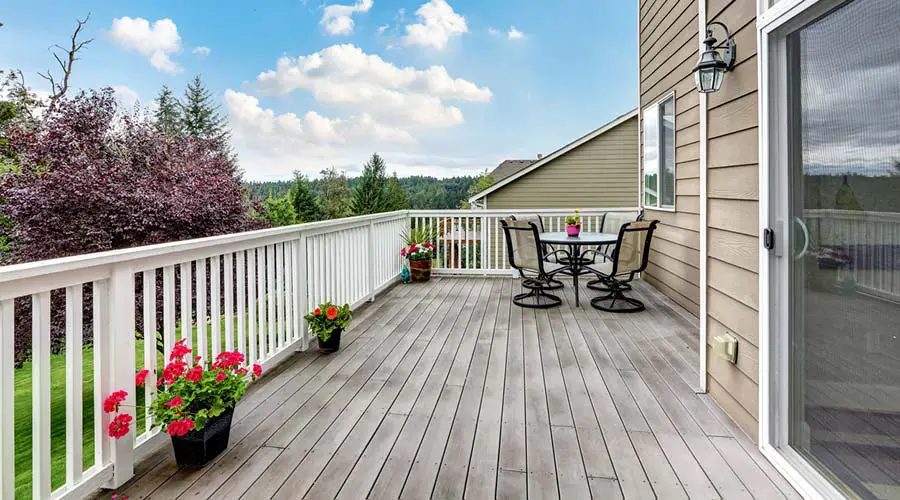
Drying a Deck Quicker
To fasten the drying process, squeeze the water off the deck. You can also have towels on the rags on the deck surface to absorb excess moisture.
DPI pressure washing recommends that you wait for at least 72 hours after cleaning to stain the deck. If it rains on any day afterward, you’ll need to wait, but everything will be worth it.
You can also cover the deck with a plastic tarp if rain follows the cleaning. Always inspect your deck before staining. If you notice some swellings or moisture in the deck, wait for an extra day or two.
It will translate into an uneven finish if you stain a wet deck. The stain can also flake off and force you to repeat the entire job. We recommend that you stain the deck on a warm and dry day for better results.

Cleaning Your Deck
Employ the lowest setting when you want to pressure wash your deck. Softwoods such as pine and cedar require about 500 to 600 psi light pressure. With hardwoods, you can use a force of between 1,200 to 1,500 psi.
You can select a rotating tip or fan to do the job. Start from 2-feets away and move closer if required. However, never get closer than 12-inches unless you’re dealing with high pressure.
Working your spray from about 18-inches will do the trick.
Always start with an area that’s easy to replace or repair. After realizing that you have chosen the best pressure setting, start working closer to your house outward.
Take care when you get corners since the cleaner, debris, and water can only outward you. Always focus on moving the rubbish first.
Can You Put 2 Coats of Stains on a Deck?
The secret is applying only as much stain as your deck can absorb. It can be two coats in most cases unless you’re dealing with dense balconies that can only soak up one coat of paint.
However, to apply the second coat after the first one, wait for 2 to 4 hours. The second coat mainly adds to intensify the color of the stain.
Tips for Staining Your Decks
Most homeowners aren’t satisfied with their deck staining project. Either the deck doesn’t last long or looks as good as expected. The tips below will guarantee you a long-lasting and great-looking result:
1. Take Your Time
It would help if you took your time with every step of your staining process. The time you invest in the process will determine the quality of your staining.
Take your time and let the new pressure treated-lumber dry out and weather for a few months before staining. It is essential to know that starting this project requires good weather.
You can leave stain strippers on the deck surface to help them break down old finishes before rinsing them off. Make sure you take your time to prevent spills and overspray, and non-target surfaces.
2. Prepare the Wood Before Staining
Preparation is critical to the end product. You must clean all the wood well before staining, including older or brand-new decks.
It would help if you cleaned brand-new lumber to eliminate mill scale, which involves crushing the grain during milling. If you leave them uncleaned, wood stains won’t penetrate the wood pores.
For those who have an older deck, it is wise to remove mildew, old stains, graying from the sun and dirt before staining.
In this case, you can use sodium percarbonate, which is otherwise known as oxygen bleach wood cleaners. However, even though they are efficient at cleaning the deck, they harm vegetation.
If old stains build up on the deck, the job will get more challenging. Instead of applying sodium percarbonate, you’ll have to employ a stain stripper. Strippers are reputable for being efficient and will remove stains with a single application.
You can also use a palm-type sander to remove small spots that won’t come off quickly during the cleaning process. Leaving the marks on the deck will appear through the new finish and detract from the surface’s final appearance.
3. Apply Wood Brighteners
Most people skip this process in the deck staining process. Even though this step is straightforward, it’ll make a significant impact on your final product.
Applying wood brighteners will neutralize the strippers used, open the wood’s surface to improve penetration, and restore the appearance of old wood.
To use brighteners, spray them on the deck and wait for a few minutes before rinsing them off. No elbow grease or scrubbing is needed.
4. Leave Cheap Stain Products Alone
After the deck finishes drying and is cleaned off, you’ll need to stain it. However, before you settle on the type of stain that you’ll be using, make sure to get a good quality product. Otherwise, your deck will suffer in the long run, hence having to pay more to fix the issue later on.
A premium product will, of course, provide premium results, so ensure you do your best to research the product before purchasing anything.
5. Inspect Waterborne Stains
It makes sense that you might be hesitant to use water-based products on your deck. However, over the last few years, they have grown increasingly popular and are very effective.
Given there are rules and regulations to almost anything you do within your home, the air quality regulations have pushed manufacturers into improving their products drastically.
Some of these water-based stains are more durable and much better than convention oil-based alternatives. They provide a unique benefit that are not available with water-based stains.
If you have a good quality stain, they have quite a bit of benefits that go along with them:
- Easier on the environment.
- Dries more quickly than most solvents.
- Does not contain toxic solvents to breathe in.
- You can clean it up with water and soap.
- It has better resistance to the weather.
- Does not require the deck to be dry completely to use them.
Some waterborne stains, such as DEFY Extreme Wood Stain, are synthetic. Synthetic colors are less susceptible to mildew, algae, and mold growth. They have a real advantage if you stay in an area with humidity and moisture.
6. Follow Product Directions
Always pay attention to what the paint and stain manufacturers say. Not every stain or paint is different, so this is an essential process.
Reading the instructions only takes you a few minutes and allows you to have the correct information before starting.
Here are some things to keep in mind before applying the paint:
- Pay attention to the time to allow the wood to weather.
- Know the period of wait time you’ll need after cleaning to start painting the deck.
- How long you should allow the wood to weather.
7. Don’t Apply too Much Stain
Decks are stained better with a semi-transparent stain. Such products allow the wood to breathe naturally, effortlessly clean and let the wood’s natural grain show through. Don’t over-apply the products and, most importantly, pay attention to the directions.
Applying too much stain will form a film that won’t allow the wood deck to breathe. Too much paint will result in peeling, so remember to use the color that the wood deck can absorb.
8. Use a Paint Brush
Deck stains can be applied in different ways. For instance, you can use a roller and pump-up garden sprayer. Regardless of the method, you select for staining, always have a brush at hand.
A paintbrush allows you to work the stain deeper into the deck pores—the friction and agitation force the deck to absorb more color. If you choose to roll or spray the paint, back-brush it with your brush while the stain is wet.
9. Allow the Stain to Cure
When the project is complete, give it more time before using it. Allow the deck to dry before you put it back to use.
The stain should cure before you expose it to the rigors of foot traffic and patio furniture. The perfect duration to allow it to sit is at least 24 hours.
10. Keep Dirt & Leaves From Damaging the Finish
Putting in a bit of effort will keep your deck looking great for longer. Here, you need to wash your deck surface regularly to keep dirt and leaves from damaging the finish.
If your deck loses its color or shows signs of graying signs, you can clean it using a light maintenance coat of stain or a little wood brightener.
Conclusion
As we have seen, decks have different materials that present exceptional levels of color and stain. You should dry for at least 48 hours for a newly washed deck before staining it.
For those on the shadow side of the house, consider leaving waiting for at least 72 hours before applying a stain or seal. However, ensure that you follow the staining guidelines to achieve good results. You can also consider consulting a professional for assistance.
Sources

